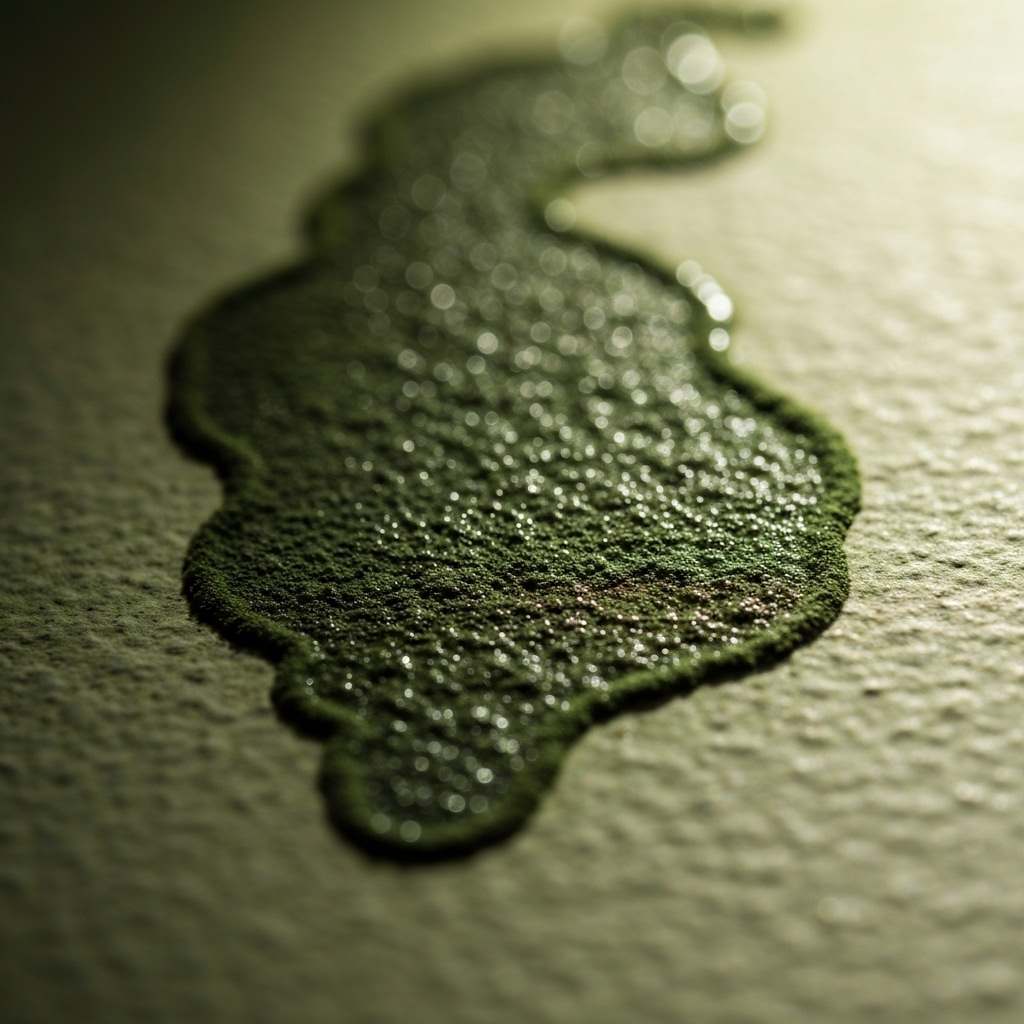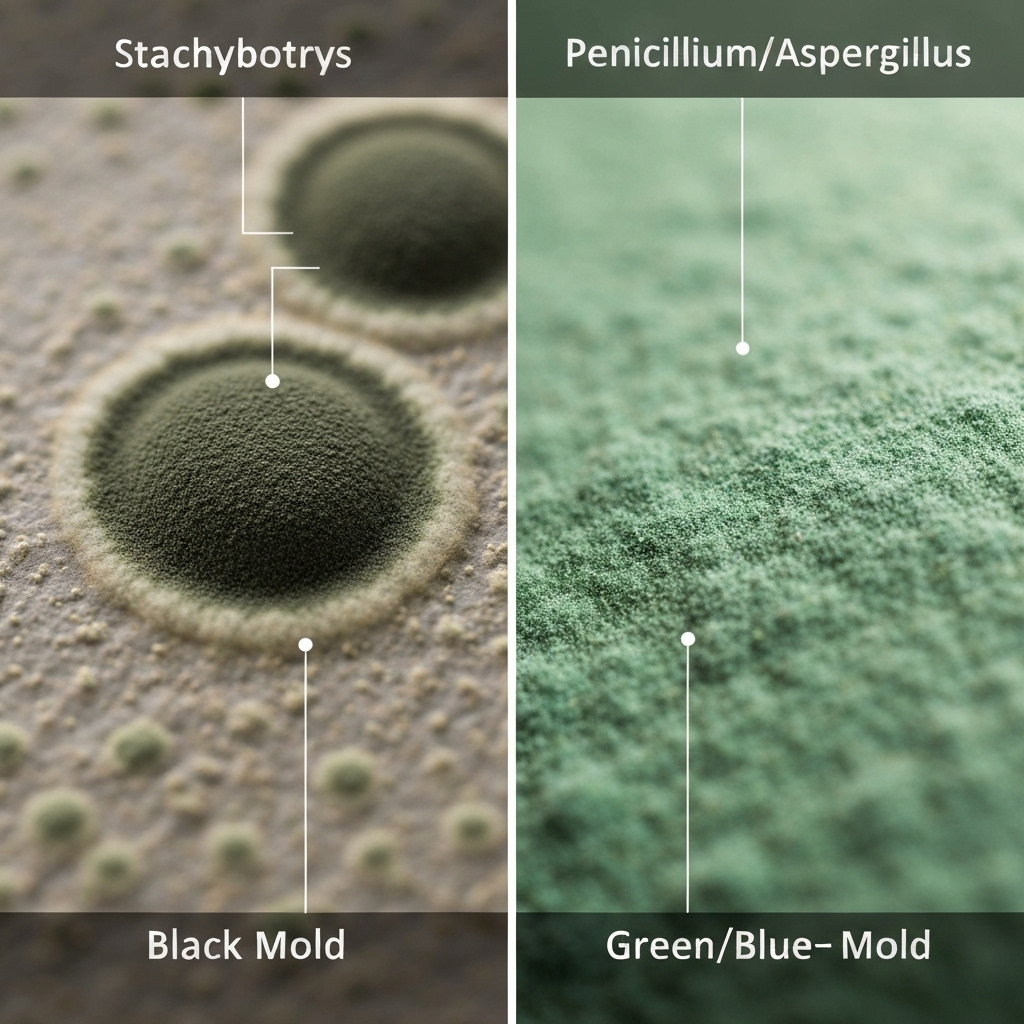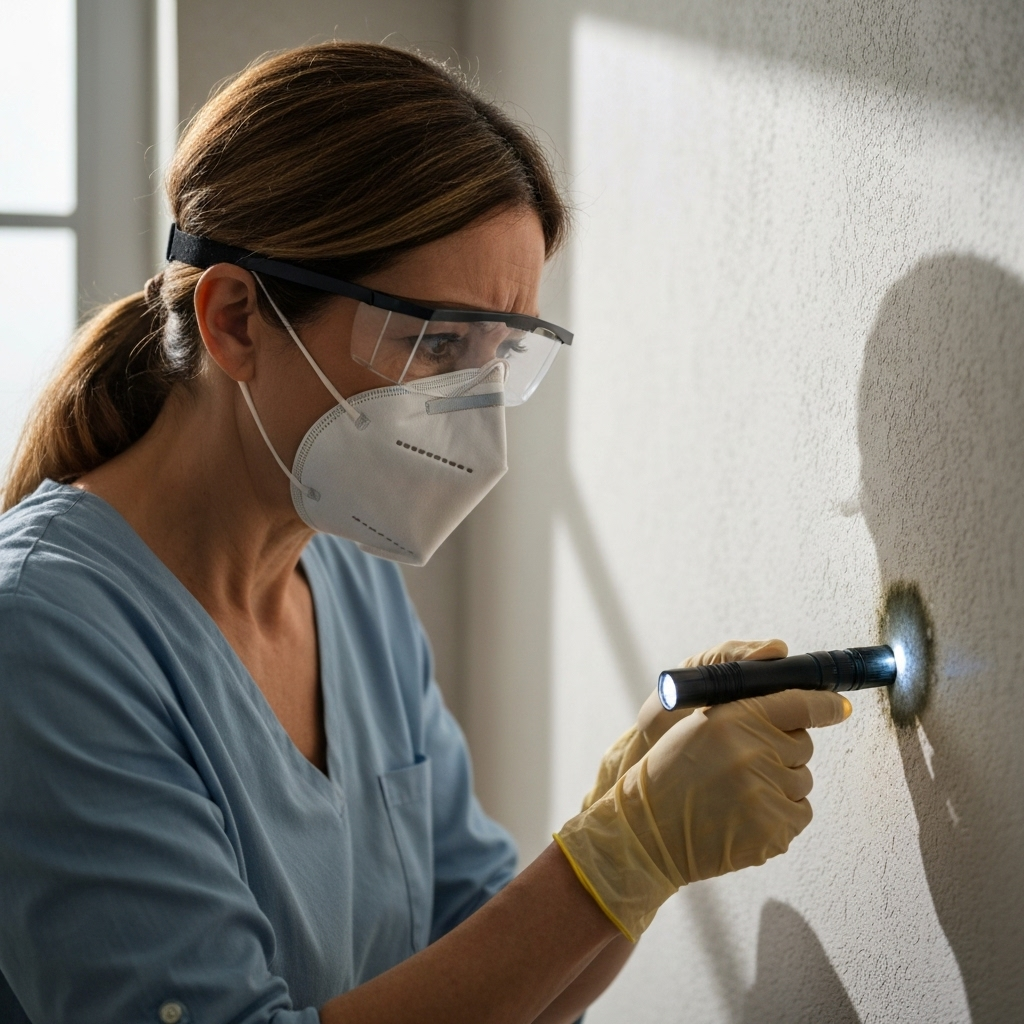Identification
Is It Dangerous Black Mold? Stachybotrys vs. Other Common Molds
Discover the key differences between Stachybotrys (toxic black mold) and other common household molds. Learn how to identify them and what steps to take.
Fast facts
- "Black mold" is a color, not a species. The infamous toxic variety is Stachybotrys chartarum.
- Stachybotrys is typically slimy and black, requiring constant, heavy water damage to grow.
- Penicillium/Aspergillus are often fuzzy and can be green, blue, yellow, or black, growing in a wider range of damp conditions.
- All mold should be removed safely, as it can cause health issues and structural damage.
- For mold growth larger than 10 square feet, always call a professional for remediation.
Photo examples




That Dark Spot in the Corner: Panic or Practicality?
You see it. A dark, ugly smudge spreading on the drywall behind the toilet or in a damp basement corner. Your mind immediately leaps to one conclusion: black mold. The term alone is enough to send a shiver down any homeowner's spine, conjuring images of hazardous material suits and costly remediation projects.
But here’s a crucial fact many people don’t realize: not every dark-colored mold is the infamous "toxic black mold." While you should take any mold discovery seriously, understanding what you might be looking at can help you move from panic to a practical, effective plan.
In this guide, we’ll break down the differences between the notorious Stachybotrys chartarum (the one people call black mold) and its more common cousins, Penicillium and Aspergillus. Knowing the difference can help you assess the situation and take the right next steps.
First, What Is "Black Mold," Really?
When people use the term "black mold," they're usually referring to Stachybotrys chartarum. This specific species has gained a fearsome reputation because it can produce mycotoxins, which are toxic compounds that can cause health issues in some individuals.
However, it’s important to clarify two things:
- Many molds are black. There are thousands of mold species, and many of them can appear black or dark green. The color alone is not enough for a positive identification.
- Not all Stachybotrys produces mycotoxins all the time. It depends on the environment, the material it's growing on, and other factors.
The key takeaway is that while Stachybotrys is a serious concern, its presence is less common than other molds. It has very specific needs to thrive, which brings us to its telltale signs.
The Telltale Signs of Stachybotrys (The Infamous Black Mold)
Stachybotrys is a picky intruder. It doesn’t just show up for any old bit of dampness. It requires constant, significant moisture to grow. Think long-term leaks, serious flooding, or heavy condensation.
Quick Visual Cues for Stachybotrys:
- Color: Typically dark greenish-black or jet black.
- Texture: This is a key differentiator. Stachybotrys is often slimy or wet to the touch because of the high moisture content it needs. If it has dried out, it may appear more sooty or powdery.
- Location: It feeds on cellulose-rich materials that have been water-soaked for a long time. Look for it on drywall, ceiling tiles, wood, and paper products that have suffered significant water damage. You're less likely to find it on a shower tile grout line, which is more commonly home to mildew or other types of mold.
- Smell: It has a distinct, strong musty or earthy odor, often described as smelling like dirt or rotting leaves.
If you see a slimy, black patch on a section of drywall that you know has been wet for over a week (e.g., from a slow pipe leak), the suspicion for Stachybotrys should be higher.
Meet the Other Common Culprits: Penicillium & Aspergillus
Far more common in homes are molds from the Penicillium and Aspergillus genera. You've definitely seen them before, even if you didn't know their names. Penicillium is famous for giving us the antibiotic penicillin (and for growing on old bread), while Aspergillus is one of the most widespread molds in our environment.
These molds are more opportunistic than Stachybotrys and can grow in a wider variety of conditions.
Quick Visual Cues for Penicillium/Aspergillus:
- Color: Highly variable. They can appear as blue, green, yellow, white, brown, or even black patches. This variety is a big clue that you're likely not dealing with Stachybotrys.
- Texture: They are characteristically fuzzy, velvety, or cottony. Think of the fuzzy blue-green spots on a forgotten orange. This is a stark contrast to the slimy nature of active Stachybotrys.
- Location: They can grow almost anywhere there's sufficient humidity. This includes wallpaper, fabrics, carpets, and even on dusty surfaces. They are also common culprits in damp basements, attics, and on food.
- Smell: Often described as musty or stale, but the intensity can vary.
While generally considered less threatening than Stachybotrys, these molds can still cause allergic reactions, asthma attacks, and other respiratory issues, especially in sensitive individuals. Any mold in your home is a problem that needs to be addressed.
Side-by-Side: Black Mold vs. The Others
Stachybotrys chartarum
- Appearance: Slimy, dark black or greenish-black.
- Environment: Needs constant, heavy water saturation.
- Common On: Water-logged drywall, wood, ceiling tiles.
Penicillium / Aspergillus
- Appearance: Fuzzy or powdery. Colors vary (blue, green, yellow, black).
- Environment: Needs only moderate dampness or high humidity.
- Common On: Almost any organic surface, including food, fabric, and dusty areas.
Your First Step: A Quick, AI-Powered Check
Trying to distinguish between mold types based on web photos can be confusing and stressful. While only a lab can give you a 100% positive identification, getting a preliminary analysis can provide immense peace of mind and guide your next actions.
This is where technology can help. Instead of guessing, you can get an instant preliminary assessment. Our tool analyzes your photo against a massive database of mold images to identify the likely type and provide immediate guidance.
Not sure if that's mold? Upload your photo to Mold Detector AI and get instant results.
What to Do When You Find Mold (Any Mold)
Regardless of whether you suspect it's Stachybotrys or a more common variety, your immediate response should be the same: act safely and strategically.
1. Safety First: Don't Disturb It!
Do not touch, scrub, or try to wipe the mold away with a dry cloth. Disturbing a mold colony, especially a dry one, can release millions of spores into the air, spreading the problem and increasing your inhalation risk. If you must be near it, wear an N95 mask, gloves, and safety goggles.
2. Document the Damage
Take clear photos of the mold growth from various angles. This is useful for your own records, for getting an analysis from a tool like Mold Detector AI, and for discussions with a professional remediation company if needed.
3. Control the Moisture Source
Mold cannot grow without water. Your absolute top priority is to find and fix the source of the moisture. Repair the leaky pipe, fix the roof, improve ventilation in the bathroom, or run a dehumidifier in the basement. If you don't solve the water problem, the mold will just come back.
4. Know When to Call a Professional
The EPA provides a clear guideline: if the moldy patch is larger than 10 square feet (roughly a 3-foot by 3-foot area), you should call a professional mold remediation specialist. Large-scale infestations require specialized equipment and containment procedures to be removed safely.
You should also call a professional if:
- The mold is in your HVAC system.
- You suspect mold is growing inside walls or under floors.
- The water damage was caused by contaminated water (like sewage).
- Someone in your household is immunocompromised or has severe asthma.
The Bottom Line: Act, Don't Panic
Seeing black mold is alarming, but knowledge is power. By understanding the visual and environmental differences between Stachybotrys and more common molds like Penicillium/Aspergillus, you can better assess the situation. Remember, Stachybotrys's slimy texture and need for severe water damage are key clues.
Ultimately, all mold is a sign of a moisture problem that needs to be fixed. Address the water source, assess the scale of the problem, and never hesitate to call in professionals for large jobs. Your home—and your health—are worth it.
Ready to put this into action?
Not sure if that's mold? Upload your photo to Mold Detector AI and get instant results.
Launch Mold Detector AI